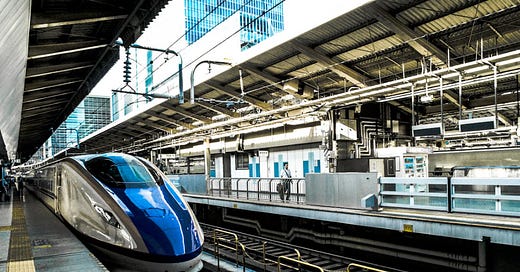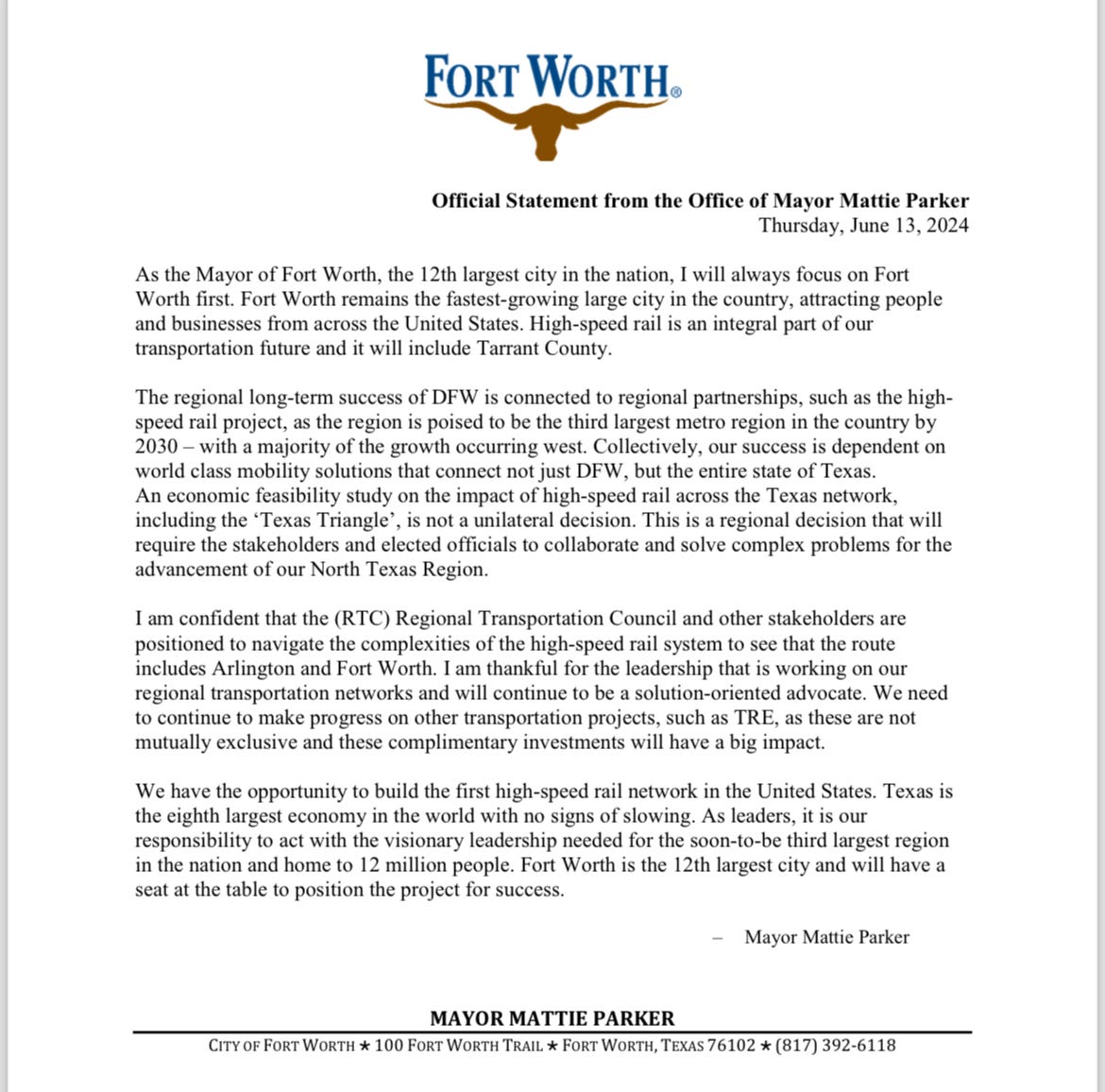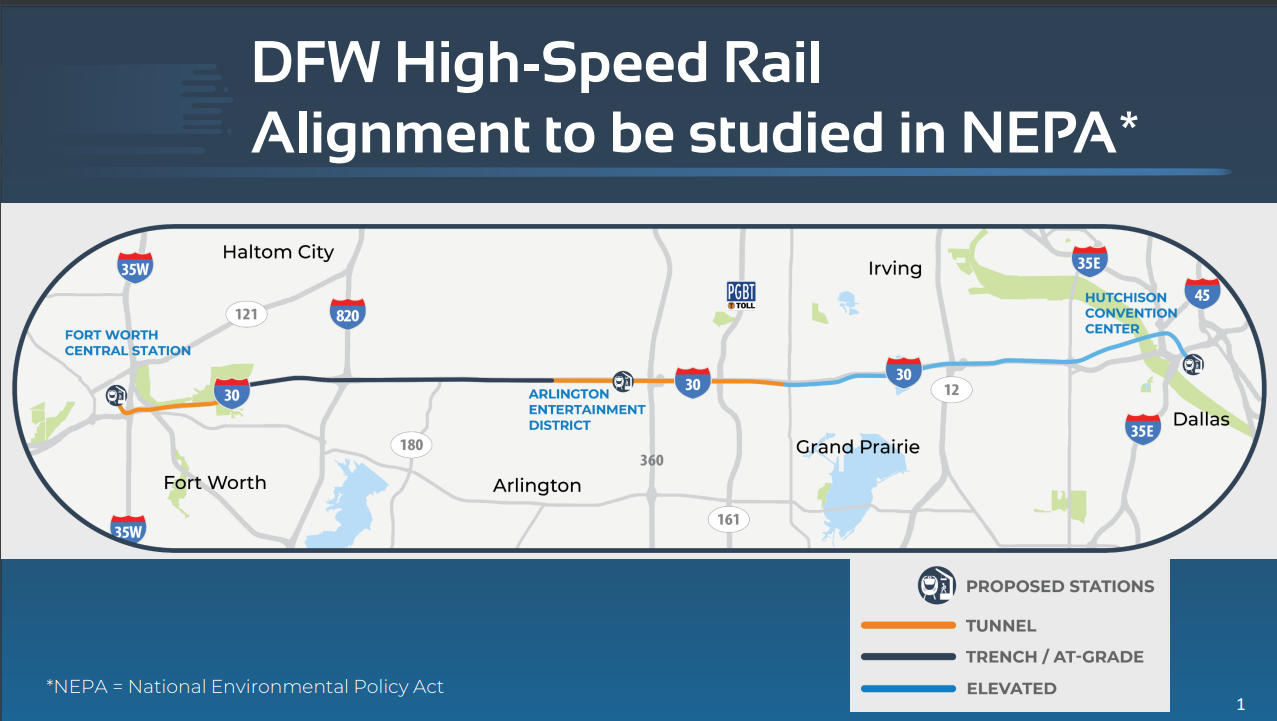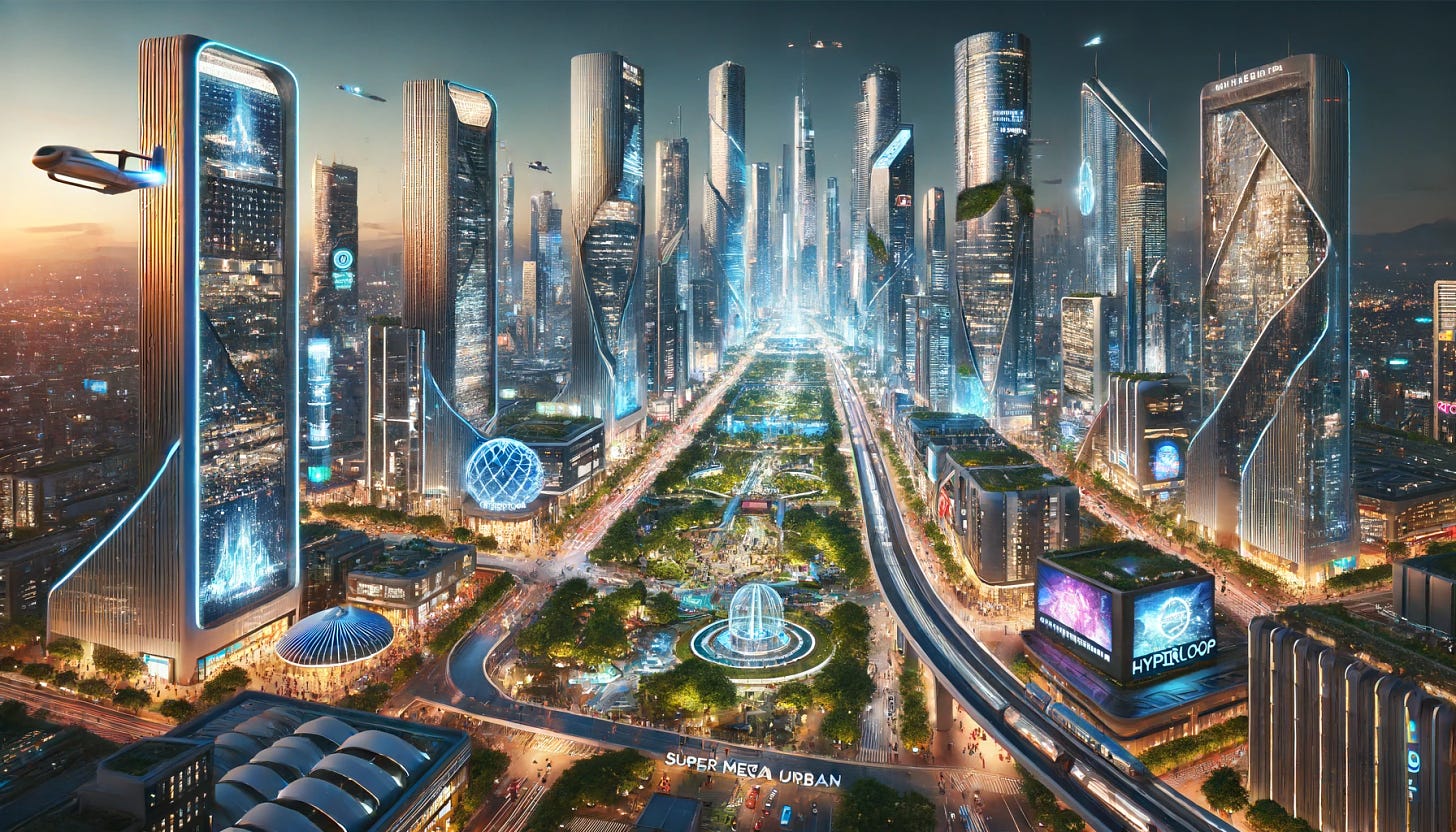Transit Tensions: The Battle Over High-Speed Rail In DFW
The Political Roadblocks to Modern Transit in DFW.
In a “non-partisan” government, how can you tell who are the actual Republicans and who are the actual Democrats? The things they say and how they vote are often indicators. Are they forward-thinking? Are they reactionary?
I don’t regularly follow politics in other cities outside of Arlington, but I will tune in if something big happens. This week, I’ve been tuning into the Dallas City Council. I was surprised to see how many Republicans are sitting on the Council.
We all know that Dallas Mayor Eric Johnson recently switched parties, undoubtedly with what came with a hefty check and the disillusion that Republicans will continue to be competitive in statewide elections. However, the issue in the City of Dallas seems to go much deeper than that. We’ll get into that, but first thing is first.
Why was I watching Dallas City Council meetings?
The North Central Texas Council of Governments (NCTCOG) - Regional Transportation Council (RTC) is a critical regional transportation policy body in North Central Texas. It serves a 16-county region centered around the Dallas-Fort Worth metroplex.
Aside from Congress, the Legislature, City Government, and County Governments, many other governmental bodies exist in a city, county, state, or even region. There are too many to name, and most don’t get much attention.
I have never paid attention to the Regional Transportation Council before. Regional Transportation—sounds boring, right?
Turns out it’s not. Not even a little.
Not only is there the kind of drama we political nerds live for, but the drama involves mayors, city council people, and commissioners from all over the DFW. It’s almost like an All-Star game.
In addition, the DFW Metropolitan Planning Organization (MPO) RTC is discussing doing some fantastic things that progressive Yes In My Backyard (YIMBY) people love. We’re talking about high-speed rail, clean environmental initiatives, green spaces, and walkable living. (More on that later.)
It all started when Fort Worth Mayor Mattie Parker posted the following letter to her Twitter:
And while her letter didn’t directly mention Arlington, her second tweet to this letter did.
As someone who lives in Arlington, I can tell you that the transportation situation is dire. Arlington is the largest city in America without a mass transit system, and trains from Fort Worth and Dallas do not come to Arlington.
This is not going to be an Arlington-centric article, but there are some essential facts to point out:
Arlington’s population is just under 400,000
Arlington is the second biggest city in Tarrant County.
The seventh biggest in Texas.
And the 50th biggest in America.
It’s also the second biggest city in Tarrant County.
And the third biggest in the entire metroplex.
It’s also home to the Texas Rangers ⚾.
And the Dallas Cowboys 🏈!
The mention of a high-speed rail system coming to Arlington got me to watch the Regional Transportation Council meetings. This was early on in the Thursday meeting.
The woman speaking at the beginning of the video (above) is Fort Worth Mayor Pro Tem Gayna Bivens, also the chair of the Council. The woman speaking off camera, representing Dallas, is Dallas City Councilwoman Cara Mendelsohn. The man Mendelsohn was talking to was a Council staff member, Deputy Executive Director Monte Mercer.
Councilwoman Mendelsohn asked the entire Council to reschedule the July workshop because the Dallas City Council members would all be on vacation then. She also mentioned Dallas’s opposition to an elevated train through downtown.
That’s when Arlington Mayor Jim Ross and Councilwoman Mendelsohn had this tense exchange:
What is this about a train?
Recently, there have been a few local stories on local media syndicates about the proposed high-speed rail between Fort Worth and Dallas. These trains would cut the average commute time from 45 minutes to 20 minutes.
According to the NCTCOG, the DFW area’s population is projected to grow 57% between 2023 and 2045, and regional employment is also expected to increase by 42%.
The proposed train would travel next to/along I30 from downtown Dallas to downtown Fort Worth, with a stop in Arlington.
Another interesting point in this meeting was discussing the 2050 population and employment estimates. The video is 14 minutes long, so I'll summarize the key points below if you don’t want to watch it.
One of the board’s primary responsibilities is to endorse and adopt a metropolitan transportation plan for the next 20 years. Believe it or not, 20 years from now is 2044, so a regional plan through 2050 makes plenty of sense.
DFW’s population is 8.1 million, which is expected to grow to 12.5 million by 2050. DFW is currently on track to surpass the Chicago area and become the third-largest metropolitan region behind New York and Los Angeles.
Dallas and Tarrant Counties will reach their capacities between 3 and 3.5 million, and Denton and Collin County populations will each exceed 2 million.
That’s a lot of growth. That’s a lot of traffic. And that’s a lot of greenhouse gases.
With DFW thundering along to become a mega-region of the future, it only makes sense to add fast commenter trains stretching from one end of the most urban area to the other.
The Regional Transportation Council will achieve many of these things because of actions by President Joe Biden.
The documentation from the RTC, which showed where the grants were coming from to do this project and others, kept mentioning two particular Biden Administration topics.
Aside from the fast train that the RTC would like to build between Dallas and Fort Worth, the RTC also has focus on:
Funding for various parks, trails, and bicycle lanes.
Improving air quality in DFW.
Reducing traffic fatalities.
Implementing smart traffic lights and smart street lights.
Helping cities get grants for electric vehicle fleets.
Increasing broadband access in DFW.
Building an infrastructure for charging electric vehicles.
That’s right. The Regional Transportation Council is going to bring us into the future.
In the future, we will have clean air and mass transit. We’ll live in cities with higher density, mixed-use developments, and high-rise residential areas, and everything will be within walking distance. It’ll be glorious—that is if Dallas doesn’t foil it.
So, what’s Dallas’ problem anyway?
We must return to their last City Council meeting, where a resolution was passed to put the breaks on the high-speed rail project until an economic impact study was returned.
The City Council stressed the necessity of an economic impact study before proceeding with any rail projects, comparing past projects like the light rail on Lancaster Road, which negatively impacted local businesses.
Council members expressed concerns about the need for clarity on the rail alignment and the potential impacts on the tax base and community development.
While it seems like a responsible government, listening to the comments from the council members reveals something else is going on here. One commenter said the TRE (Trinity Railway Express), which goes to Fort Worth, is sufficient.
The TRE is insufficient for Arlington because the closest train station could still be a 45-minute drive in rush hour traffic.
Another City Council member inferred that the highway (I30) was enough for Arlington.
Since the projected growth of the overall DFW area by 2050 is 12.5 million, all that extra traffic on I30 would be a nightmare, especially as you approach the mixmaster in Dallas. Relying only on traffic to support us through population booms while we have an option of other forms of transit is not smart.
At one point, two of the Councilwomen discussed how they hated driving underneath overpasses during rush hour and their concern about these trains bringing more overpasses they have to go underneath.
Another Council member asserted a train from Dallas to Fort Worth wasn’t necessary.
Really, what’s Dallas’ problem?
Councilwoman Mendelsohn let the cat out of the bag during the February meeting.
She said, “Arlington and Fort Worth had below-ground trains. Why is Dallas’ above-ground?” She discussed Dallas’ new convention center and how this is supposed to be a walkable area.
Then, Councilwoman Mendelsohn threw Arlington directly under the bus and said that another RTC member said ten years ago that Arlington would not get a stop until it made a significant investment in transit (a shot directly at Arlington’s lack of mass transit).
For those of you who watch body language, it’s interesting to watch Arlington Mayor Jim Ross’ body language as Mendelsohn threw his city under the bus. Ross is at the top left, in the blue shirt.
Mendelsohn went on to say that a shuttle to the TRE should be sufficient enough for Arington. (It’s not.)
It looks like this is when the Arlington vs. Dallas beef started.
Oh, yes. Mayor Ross responded.
Before we start all this, #TeamDallas, #TeamArlington, stuff, the idea is for them to work together on solutions that will benefit everyone, not one city or the other.
Having their economic impact study is responsible government from Dallas. Still, they should (and probably are) look at it from an environmental perspective and how traffic will look as DFW grows into a “mega-region.”
What now?
We’ll have to wait for their economic impact study and see what happens in future meetings, but the prospects are exciting. While Dallas is rightfully insisting on an economic impact study to ensure that the rail project does not negatively affect its tax base and development, it mustn’t stall progress that benefits the entire DFW metroplex.
Arlington’s transit needs are dire, and a high-speed rail stop would significantly alleviate traffic congestion and connect its residents more effectively to the broader region in the decades to come. The projected population growth demands forward-thinking solutions, and the high-speed rail presents an opportunity to enhance mobility, reduce greenhouse gas emissions, and promote sustainable urban development.
In the end, cooperation and compromise are essential. No matter what beef Dallas seems to have, Arlington cannot be left out of the equation.
The RTC’s vision for a greener, more connected metroplex aligns with equity and environmental justice. Embracing these initiatives will propel the region into a leading example of modern urban planning and sustainability.
142 days left until the November 5 election!
LoneStarLeft’s Newsletter is a reader-supported publication. To receive new posts and support my work, consider becoming a free or paid subscriber.
Follow me on Facebook, Twitter, TikTok, Threads, YouTube, and Instagram.









How can the public get involved or organize for this?